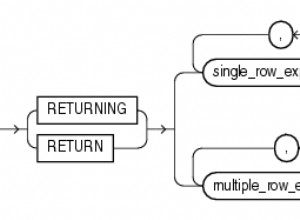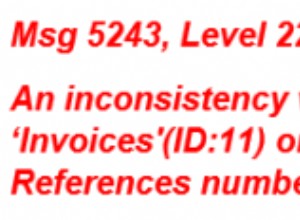Mmm . . . Un método es obtener el último valor. Luego elija todas las últimas filas con ese valor y agregue:
select min(rownum), colA, colB
from (select t.*,
first_value(colA) over (partition by colB order by rownum desc) as last_colA
from t
) t
where rownum > all (select t2.rownum
from t t2
where t2.colB = t.colB and t2.colA <> t.last_colA
)
group by colA, colB;
O, sin la agregación:
select t.*
from (select t.*,
first_value(colA) over (partition by colB order by rownum desc) as last_colA,
lag(colA) over (partition by colB order by rownum) as prev_clA
from t
) t
where rownum > all (select t2.rownum
from t t2
where t2.colB = t.colB and t2.colA <> t.last_colA
) and
(prev_colA is null or prev_colA <> colA);
Pero en SQL Server 2008, tratemos esto como un problema de lagunas e islas:
select t.*
from (select t.*,
min(rownum) over (partition by colB, colA, (seqnum_b - seqnum_ab) ) as min_rownum_group,
max(rownum) over (partition by colB, colA, (seqnum_b - seqnum_ab) ) as max_rownum_group
from (select t.*,
row_number() over (partition by colB order by rownum) as seqnum_b,
row_number() over (partition by colB, colA order by rownum) as seqnum_ab,
max(rownum) over (partition by colB order by rownum) as max_rownum
from t
) t
) t
where rownum = min_rownum_group and -- first row in the group defined by adjacent colA, colB
max_rownum_group = max_rownum -- last group for each colB;
Esto identifica cada uno de los grupos usando una diferencia de números de fila. Calcula el número de fila máximo para el grupo y en general en los datos. Estos son los mismos para el último grupo.




